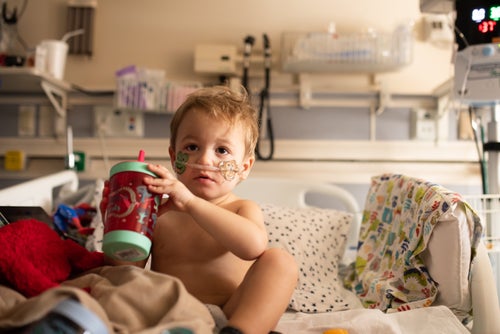

Childhood pneumonia cases have risen by more than 50%, according to NHS Digital data.
The data, analysed by Unicef and Save the Children, found there were 56,210 emergency admissions in England for pneumonia in those aged 18 or younger between April 2018 and March 2019. Between April 2008 and March 2009, there were 36,862 admissions.
This increase is driven by a large rise in bronchiolitis, the data suggested.
Pneumonia is particularly prevalent in the autumn and winter months. It’s often caused by a bacterial infection, which leads to the tiny air sacs in the lungs becoming inflamed.
“This can result in breathing difficulties,” Dr Nitin Shori, medical director of the Pharmacy2U Online Doctor service, tells HuffPost UK. “In some cases, pneumonia can lead to serious complications and can even be fatal.”
What is pneumonia?
“Pneumonia is the medical name given to an inflammation of the soft tissue in the lungs,” explains Dr Shori.
“Infection with the streptococcus pneumoniae bacteria is the most common cause of ‘community-acquired’ pneumonia. But it can also be caused by a virus or even exposure to certain types of fungi.”
The illness can affect people of any age but can be more serious for vulnerable patients, including young children, the elderly, and people with serious pre-existing medical conditions.
Symptoms
According to the NHS, pneumonia symptoms can develop suddenly over 24 to 48 hours, or they may come on more slowly over several days.
Common symptoms include: a cough (which can lead to the production of thick, coloured phlegm), difficulty breathing, rapid heartbeat, fever, generally feeling unwell, sweating and shivering, loss of appetite or chest pain.
Less common symptoms include: coughing up blood, headaches, fatigue, nausea or vomiting, wheezing, joint and muscle pain, and confusion.
Diagnosis
“A doctor will normally diagnose pneumonia using the symptoms outlined by a patient and through a chest examination,” explains Dr Shori.
“Further tests are sometimes required as pneumonia can be difficult to diagnose because it shares many characteristics with less serious conditions, including coughs and colds.
“A chest X-ray and blood tests can be useful in establishing the diagnosis.”
Treatment
Dr Shori says: “Patients with pneumonia are usually given antibiotics and advised to rest and drink plenty of fluids.
“People at high risk of pneumonia can be often offered vaccination against the pneumococcal vaccine.”
He concludes: “Anyone who believes they might have pneumonia should see a GP. It’s important for anyone with breathing difficulties to seek urgent medical attention.”